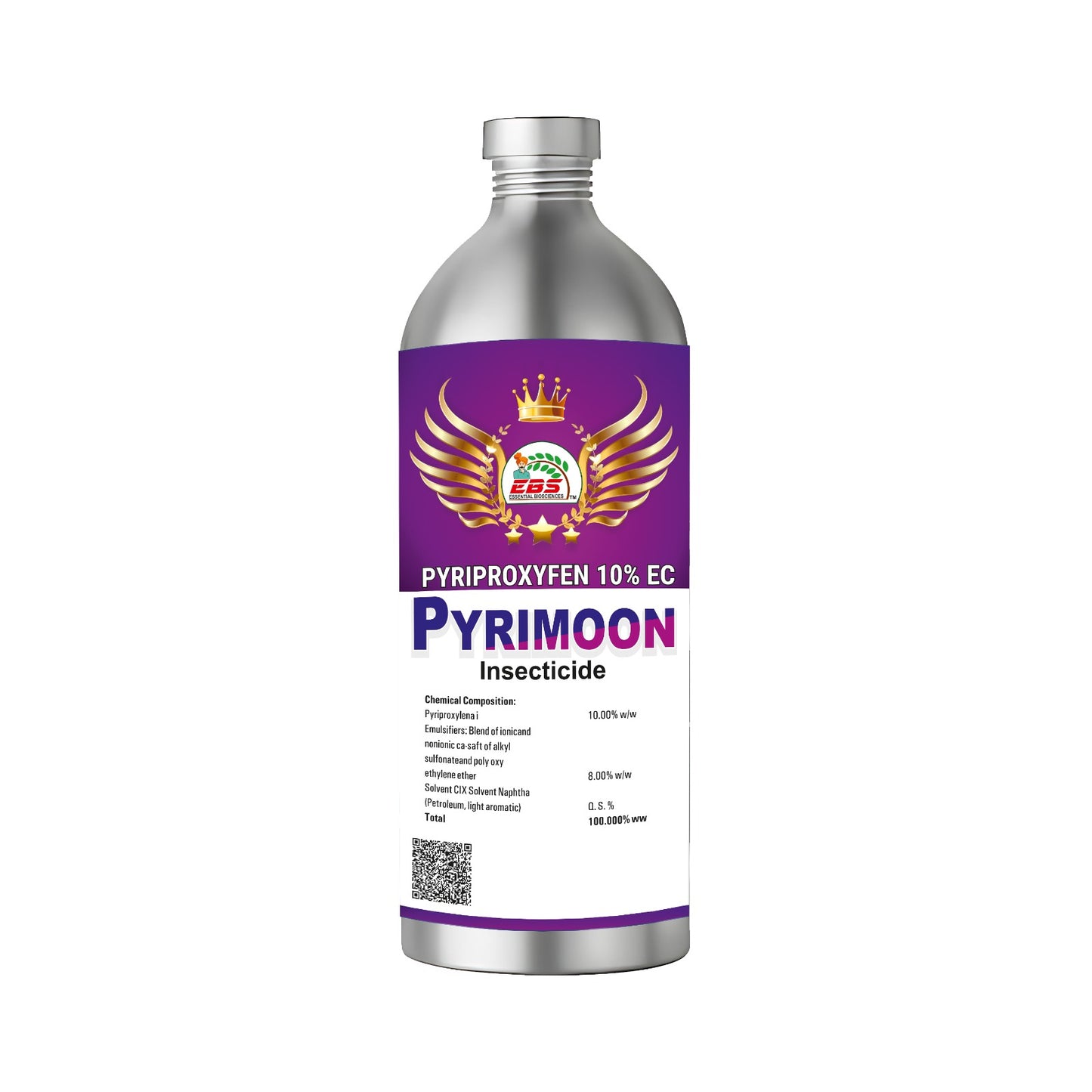
ESSENTIAL BIOSCIENCES
EBS PYRIMOON Lano Pyriproxyfen 10% EC Insecticides, Pyridine-Based Pesticide Used Against Variety Of Arthropoda.
EBS PYRIMOON Lano Pyriproxyfen 10% EC Insecticides, Pyridine-Based Pesticide Used Against Variety Of Arthropoda.
Couldn't load pickup availability
- Whatsapp or call for bulk orders: 9399022060
- Cash on Delivery Available for All customers in India
- Free Agri Expert Service Available
EBS PYRIMOON Lano Pyriproxyfen 10% EC
1. Product Overview:
Pyriproxyfen 10% EC (Emulsifiable Concentrate) is a broad-spectrum insect growth regulator (IGR) used for the effective control of juvenile-stage insect pests. It mimics juvenile hormones, disrupting the normal development and reproduction of target insects. This prevents immature insects from maturing into reproductive adults, thereby breaking the life cycle of pests. The EC formulation ensures excellent solubility, improved adhesion, and uniform application, making it highly effective in pest management programs.
2. Mode of Action:
Pyriproxyfen acts as a juvenile hormone analog (JHA). It interferes with the hormonal balance of insects, preventing metamorphosis from the larval or nymphal stage to the adult stage. This disruption reduces the population of mature, reproductive adults, effectively controlling pest populations over time.
-
Ovicidal and larvicidal activity: Prevents eggs from hatching and larvae from developing into adults.
-
Sterilizing effect: Reduces the fertility of adult females, further lowering the pest population.
3. Target Pests:
Pyriproxyfen 10% EC is highly effective against a range of insect pests, including:
-
Whiteflies (Aleyrodidae)
-
Aphids (Aphididae)
-
Thrips (Thripidae)
-
Jassids (Cicadellidae)
-
Mealybugs
-
Mosquito larvae (in public health applications)
-
Scale insects
4. Crops:
Pyriproxyfen 10% EC is registered for use on various crops, including:
-
Cotton: Controls whiteflies, aphids, and jassids.
-
Vegetables (Tomato, Okra, Brinjal, Chilli): Protects against whiteflies, thrips, and aphids.
-
Fruits (Citrus, Mango, Grapes): Manages scale insects and mealybugs.
-
Tea and coffee: Effective against whiteflies and aphids.
-
Ornamental plants and nurseries: Used for controlling sucking pests.
-
Public health applications: Effective in mosquito control programs by preventing larvae from maturing.
5. Application and Dosage:
-
Foliar Spray: 1.0–1.5 ml per liter of water (depending on the crop and pest intensity).
-
Frequency: Apply at the first sign of pest infestation and repeat at 10–15 day intervals if necessary.
-
Method: Spray evenly on both sides of leaves, ensuring thorough coverage.
-
Public health use: For mosquito control, apply at 0.01–0.05 ppm in water bodies.
6. Benefits:
-
Effective life cycle disruption: Prevents immature insects from maturing, reducing the adult population.
-
Long-lasting residual control: Provides extended protection by sterilizing adult pests and preventing further reproduction.
-
Ovicidal and larvicidal action: Kills eggs and larvae, preventing future generations.
-
Low mammalian toxicity: Safe for use in IPM programs when applied correctly.
-
Reduced resistance risk: Acts on the hormonal system, reducing the likelihood of resistance development.
-
Rainfastness: Quickly absorbed by plants, ensuring resistance to wash-off by rain.
-
Improved crop quality and yield: Reduces pest damage, enhancing overall agricultural productivity.
7. Precautions and Safety:
-
Use protective gear (gloves, mask, and goggles) during handling and application.
-
Avoid spraying during flowering stages to protect pollinators like bees.
-
Follow the recommended pre-harvest interval (PHI) to avoid residue issues.
-
Store in a cool, dry place away from food, feed, and water sources.
-
Prevent drift to non-target areas, especially water bodies.
8. Environmental Impact:
-
Toxicity: Pyriproxyfen is highly toxic to aquatic organisms and moderately toxic to bees.
-
Persistence: It has moderate persistence in the environment and degrades slowly in water bodies.
-
Pollinator safety: To minimize harm, avoid application during bloom stages.
✅ Conclusion:
Pyriproxyfen 10% EC is a highly effective insect growth regulator that controls a wide range of pests by disrupting their life cycle. Its long-lasting residual control, ovicidal and larvicidal action, and reduced resistance risk make it an essential tool for integrated pest management (IPM) programs. With proper application, it ensures healthier crops, improved yields, and effective pest population management.


